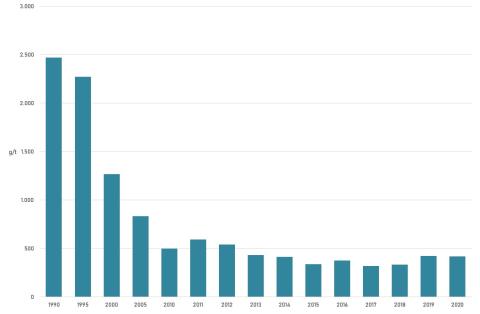Panel 1
Riccardo de Lauretis
The indicator relates the total atmospheric emissions generated by production processes in the steel sector to the total amount of steel produced, in order to assess the specific emissions generated per unit of steel production. Between 2019 and 2020, all considered substances show a slight decrease. The magnitude of fluctuations in recent years, starting from 2012–2013, is modest.
The indicator relates total atmospheric pollutant emissions generated by production processes in the steel industry to the total amount of steel produced, in order to assess the specific emissions from steel production. The atmospheric pollutants considered are SOx (sulphur oxides), NOx (nitrogen oxides), CO (carbon monoxide), NMVOCs (Non-Methane Volatile Organic Compounds). The emissions used in the calculation of the indicator are estimated using appropriate methods in accordance with EMEP/EEA guidelines and are updated annually. Each yearly update involves a revision of the entire historical series based on improved information and the latest methodological developments. This revision process may lead to significant changes in previously reported historical data. Given the level of aggregation chosen, the indicator provides information on the environmental performance of the entire sector rather than individual production processes.
The purpose is to assess the specific emissions generated by steel production.
Specific environmental emissions from the industrial sector are regulated by Directive 2010/75/EU of 24 November 2010, transposed into Italian law through Legislative Decree of 4 March 2014, No. 46, which amended Legislative Decree 152/06, and subsequent amendments.
This legislation defines, for each industrial sector, the obligations regarding pollution prevention and reduction, including the adoption of Best Available Techniques (BATs).
In accordance with Directive 2010/75/EU, information exchange must also be ensured across the European Community, including emissions data for activities subject to Integrated Environmental Authorization (IEA/AIA).
Panel 2
Rapporto ISPRA 361/2022 - ”Italian Emission Inventory, 1990-2020. Informative Inventory report 2022”
-
-
Data quality assessment
Federacciai, ISPRA (Superior Institute for Environmental Protection and Research), ISTAT (National Institute of Statistics)
The activity data and emissions are documented in the National Atmospheric Emission Inventory and in particular in ISPRA Report 361/2022 - "Italian Emission Inventory, 1990-2020. Informative Inventory report 2022" and in the tables with emission data by category officially reported by Italy under the UNECE/CLRTAP Convention.
National
1990-2020
Indicator assessment
Ratio between emission data estimated by ISPRA for the National Atmospheric Emissions Inventory and steel production data published by ISTAT and Federacciai.
In 2020 compared to 2019, SOx emissions per tonne of steel produced (420.6 g/t) remained practically unchanged (less than 1% decrease); NOx (482.3 g/t) decreased by 5.9%, NMVOCs (216.4 g/t) by 4.6%, and
CO (5,574.8 g/t) by 7.4%. The overall situation can be considered stable.
Examining the time series from 1990 to 2020, all observed pollutants have significantly decreased.
Specifically, the reduction in emissions per unit of product was 83% for SOx, 62% for NOx, 50% for NMVOCs, 66.5% for CO.
Data
Tabella 1: Specific emissions in the steel industry
ISPRA elaboration on data from ISPRA, ISTAT and Trade Associations.





From 1990 to 2020, specific emissions of key pollutants (SOx, NOx, NMVOCs, and CO) have decreased compared to 1990, with reductions ranging from 49.9% for NMVOCs to 82.9% for SOx (see Table 1 and Figures 1, 2, 3, and 4).
For all substances considered, the largest reductions occurred between 1990 and 2010. Since 2010, the variation in emissions has been modest.